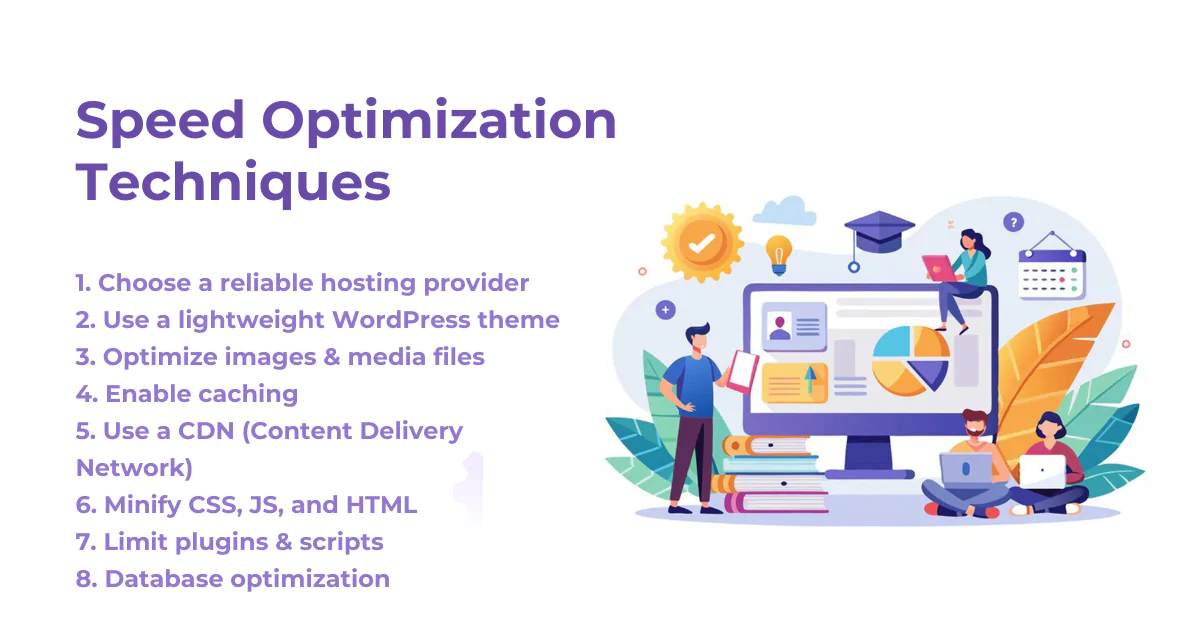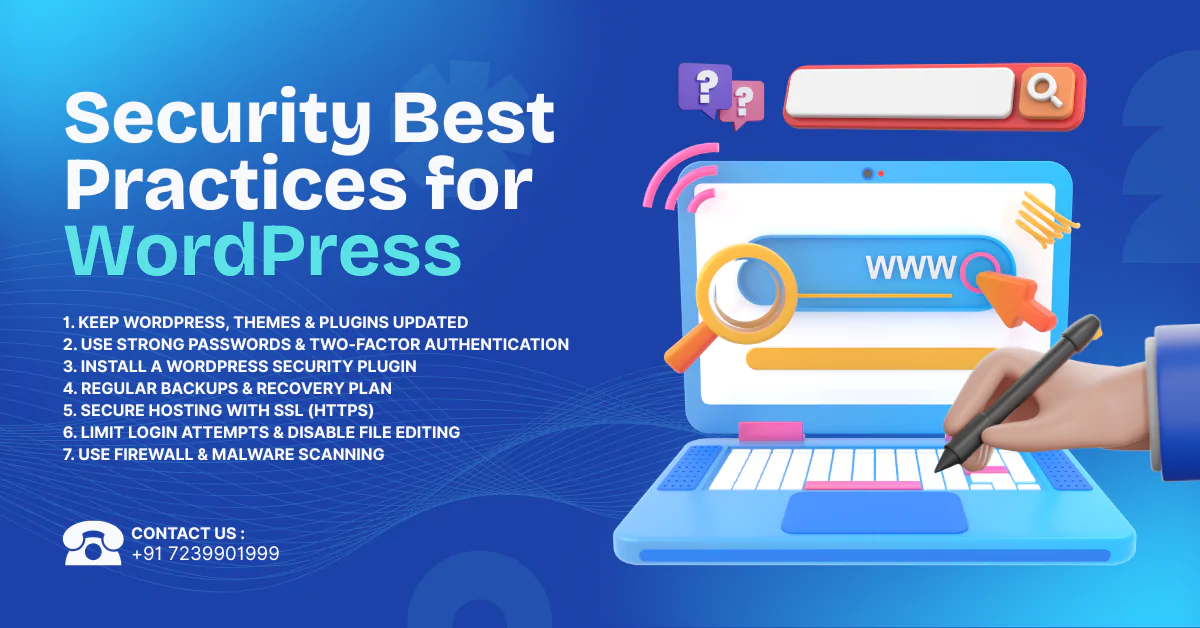The first thing people notice on your website is speed. If it loads fast, they stay. If it takes too long, they close the tab and never come back. The same goes for security. If your site looks unsafe, nobody is going to type their email, add card details, or buy anything.
Both speed and security are the most important things when you run a website. A fast website improves, for example, user experience, keeps people browsing, and helps with search rankings. A secure website, at the same time, builds trust, protects data, and makes people feel safe while shopping or reading. Google has made it clear: speed and HTTPS security are ranking factors. If you ignore them, your traffic and conversions will drop.
Here’s the hard truth: even a one-second delay can reduce your sales, and even a small security flaw can expose your customer data. WordPress runs most of the websites you see today. But because it’s so common, it’s also the first target for hackers. Thousands of sites get attacked every single day.
And to handle this, for example, you are supposed to be a tech person. With a few steps, you can increase your WordPress site speed. And you can also make it a secure website. In this guide, we will discuss the following topics.
🔒⚡ Improve WordPress Speed & Security
Optimize load times, enhance Core Web Vitals, and protect your site from vulnerabilities with our expert WordPress solutions.
Why WordPress Websites Need Extra Care
WordPress is everywhere. From small blogs to big eCommerce stores, millions of websites run on it. That’s the strength of WordPress, but also its weakness. Because it’s the most popular CMS in the world, it’s also the biggest target for hackers. Reports show that WordPress alone faces thousands of attacks daily, from brute force logins to malware injections.
Now let’s talk about speed. Most WordPress sites slow down over time. Why? Too many plugins, heavy themes, uncompressed images, or messy coding. When you use unreliable hosting, your site will take longer to load. A slow website not only irritates your visitors, but it also damages your SEO and reduces sales.
This is why WordPress websites need extra care. You just built a site and left the work. Now things are not going to work. You have to maintain, update, and keep your website secure. You should manage it like a shop. For example, if you don’t just open it once and walk away. You clean it, fix things when they break, and lock it at night. If you ignore it, sooner or later, it will slow down or get hacked. Your WordPress site works the same way.
Speed Optimization Techniques

1. Choose a reliable hosting provider
Hosting is the base of your website. If your hosting is weak, nothing else will matter. Cheap shared hosting slows your site because you are sharing space with hundreds of other sites. Your visitors don’t care why your site is slow; they just leave. If you really want speed, you need to pick a good hosting plan. Yes, it costs more, but it saves you lost customers. Even a WordPress website development company will first ask you to upgrade hosting before they touch anything else. Because hosting alone can cut your load time by half.
2. Use a lightweight WordPress theme
Themes are so amazing, but most heavy themes are full of sliders, animations, and effects. These things slow you down badly. You don’t need a theme that tries to do everything. What you need is a simple, lightweight theme that opens fast on mobile and desktop. Let’s assume your store is a shop, would you fill it with too much decoration so customers can’t even walk around? You would not do that, right? The same rule applies here.
3. Optimize images & media files
Big images are the number one reason for slow sites. If you upload a photo straight from your phone or camera, it will be too heavy. You must compress it before uploading. You can use some free tools to do that. Or you can also use WordPress speed optimization plugins that cut the size but keep the image clear. Even reducing a 2MB file to 200KB makes a huge difference. And nobody will even notice the difference in quality, but they will notice the speed.
4. Enable caching
Without caching, every time someone visits your site loads fresh from zero. That means it fetches the same files again and again. And when you add caching, a copy of your site is saved on the user’s device. And whenever your user visits your website, it opens instantly. To get started, you can use plugins like W3 Total Cache or WP Rocket. With caching turned on, your pages can load in half the time. It’s like keeping your shop’s door open so customers don’t have to wait for your door to open every time.
5. Use a CDN (Content Delivery Network)
If your visitors are from different countries, a CDN is a must. A CDN stores copies of your site on different servers across the globe. So if someone opens your site in California, they get it from the California server, not from your Indian one. This is how you will be able to keep things very smooth. To understand this concept, you can take an example of setting up warehouses in different cities instead of shipping everything from one shop. Big brands do that so they can deliver faster. You can do the same for your site.
6. Minify CSS, JS, and HTML
Your website runs on code. But most themes and plugins add extra junk, spaces, comments, and lines that make files heavy. Minifying means cleaning all that. You don’t need to touch code yourself; plugins can do it. Once files are minified, your site feels lighter and faster. It’s like removing dust and useless papers from your shop’s counter; you make space and things work smoothly.
7. Limit plugins & scripts
Plugins are powerful, but too many of them ruin your site. Each plugin loads its own files, which makes your site slow. Be honest, do you really need all the plugins you installed? Remove the ones you don’t use. Keep only the important ones. And don’t install three plugins for one job. If one plugin can do three tasks, stick with it. Same way, don’t add random scripts or trackers unless you need them.
8. Database optimization
The database of a WordPress website stores everything. And everything means your posts, pages, comments, and even junk like old revisions and spam. Over time, it becomes full and slows down your site. That’s why you should clean the database once a month. It’s easy to do with tools like WP-Optimize, or your developer can do it for you. If you don’t, useless things keep piling up, and your shop becomes harder to manage. Keep your database lean, and your site will always feel fresh.
Also Read – Tips for Optimizing Page Speed on WordPress
Security Best Practices for WordPress

1. Keep WordPress, themes & plugins updated
We don’t know if you know this, but hackers love outdated websites. Old versions of WordPress, plugins, or themes always have security holes. That’s where hackers sneak in. You can stop this easily, keep everything updated. And if you update, don’t think that an update would just add new features. But an update comes with some bug fixes and closes those security holes.
2. Use strong passwords & two-factor authentication
Weak passwords are like leaving your shop open at night. Anyone can walk in and steal everything. You should always use strong passwords. And the password should be mixed with letters, numbers, and symbols. And please, don’t use your name, birthday, or admin123. On top of that, enable two-factor authentication (2FA). It adds another lock. Even if someone cracks your password, they won’t get in without your phone code.
3. Install a WordPress security plugin
You can’t monitor your site 24/7. But a good security plugin will. Tools like Wordfence or iThemes Security act like guards for your site. These plugins block suspicious logins, scan files for malware, and alert you if anything wrong is about to happen.
4. Regular backups & recovery plan
No system is 100% safe, though. If something goes wrong, you can always roll out the backup. You should keep regular backups of your site files and database. You can save the backup files in your system or use a cloud server. This way, even if you get hacked, you can restore your site in minutes instead of starting from scratch.
5. Secure hosting with SSL (HTTPS)
A secure hosting plan with SSL is non-negotiable. SSL (the green lock you see in the browser) protects the data sent between your site and users. Without SSL, login details and payments can be stolen by hackers. Plus, Google ranks HTTPS sites higher. So it’s not just security, it’s also SEO.
6. Limit login attempts & disable file editing
Most hackers don’t break in on the first try; they keep guessing passwords again and again. By limiting login attempts, you block them after a few tries. Also, disable file editing from your WordPress dashboard. If a hacker ever gets inside, file editing gives them an easy way to add malicious code. Turning it off removes that chance.
7. Use firewall & malware scanning
A firewall acts like a gate, for example. It blocks bad traffic before it even reaches your site. Combine that with malware scanning, and you have a solid defense. Many hosting providers and plugins offer this built-in. It’s like having security guards outside your shop plus a scanner inside to catch hidden threats.
Tools & Plugins to Help
Speed Optimization Tools
You don’t need to assume whether your site is fast or slow. There are free tools that tell you the truth in seconds.
- GTmetrix: Just type your website link, and it shows you how long your site takes to load, what’s slowing it down, and where to fix it.
- Google PageSpeed Insights: Straight from Google. It scores your site speed on mobile and desktop, plus gives you tips to improve.
- Pingdom: Another tool that checks speed and uptime. It also tells you how your site performs from different locations in the world.
Security Plugins & Monitoring Tools
Speed is important, but security is equally critical. You don’t want your site hacked after all your hard work. These plugins make your job easier:
- Wordfence: Acts like a firewall. Blocks hackers, scans for malware, and alerts you if something looks fishy.
- iThemes Security: Helps with login protection, two-factor authentication, and overall site hardening.
- Sucuri: One of the best for malware scanning and firewall protection. It’s trusted worldwide.
Ongoing Maintenance Tips
Regular Audits for Speed & Security
Your WordPress site won’t take care of itself. If you leave your WordPress website and do nothing, sooner or later, it will slow down or face security problems. This is why you need to maintain it. One of the easiest WordPress speed optimization tips is to check your site every few weeks with tools like GTmetrix or Google PageSpeed. Look for heavy images, unnecessary plugins, or theme updates that might be dragging your site. Along with that, scan for security issues. Even a small infected file can stay hidden and cause big trouble later. Regular audits make sure you find problems before they hit you.
Scheduling Backups & Monitoring Uptime
No matter how careful you are, sometimes things can still go wrong. A plugin update can destroy your site. And sometimes, the server may crash, or someone may try to hack it. That’s why you must always keep backups ready. You can take daily or weekly backups, because a backup file lets you restore your site in minutes. Also, watch your uptime closely. If your site keeps going down, you’ll lose both customers and trust. Simple free tools like UptimeRobot will send alerts when your site goes offline. Or you can work with a WordPress Development Services team that handles backups and monitoring for you. That way, you’ll never have to wait for an angry customer to tell you your site is down.
🚀 Boost WordPress Speed & Stay Secure
Slow site? Security risks? Get faster load times, stronger protection,
and better user experience with our WordPress optimization services.
Final Thoughts
Now, there you have it. After reading this article, you might have learned that speed and security are not extras anymore. But you need to work on security as well as speed. And to do that, you don’t need to be a tech pro. Using the steps that we have mentioned in this guide, you can improve the speed and security of your website.
And remember, if you’re not technically sound, you don’t have to do it all alone. You can work with a WordPress website development company that can set up speed optimization, security, and long-term support for you.
As a leading WordPress website development company, we have delivered so many successful projects. Our team is so experienced, they will be working with you from day one. Having said that, if you need any help, we are here. You can call or message us, and one of our consultants will get in touch with you.
FAQs
1. What slows down a WordPress website the most?
Well, a WordPress website might feel slow with so many reasons. For example, if you have used heavy images, too many plugins, and cheap hosting, your website would be slow.
2. How often should I update my WordPress site?
Every time you see a new update, you should click on the update button right away.
3. Which are the best WordPress speed optimization plugins?
W3 Total Cache, WP Rocket, and LiteSpeed Cache are good options. These plugins handle caching and help you increase WordPress loading speed without much technical setup.
4. Do I really need a security plugin for WordPress?
Yes. A plugin like Wordfence or iThemes Security acts like a guard for your site. It blocks suspicious activity before it turns into a real attack.
5. How can I make my WordPress website safe from hackers?
You should use strong passwords, enable two-factor login, keep backups, and use SSL. Also, limit login attempts.
6. Is free hosting safe for WordPress sites?
No. Free hosting is unreliable and unsafe. Always go with a trusted paid hosting. A good host not only gives speed but also better security.
7. Can I handle speed and security myself, or should I hire experts?
You can do the basics yourself. But if you run a serious business, you should hire an agency and take their WordPress development services.

